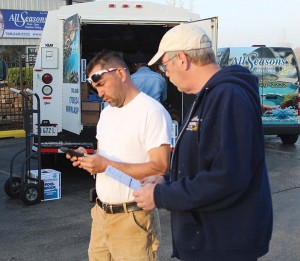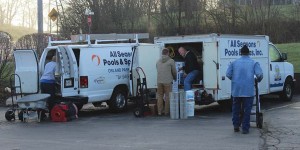Service is the backbone of the aquatics industry. Once a pool and/or spa/hot tub is installed, it needs to be serviced so homeowners continue to enjoy their backyard investment. In most cases, the service technician is the face of the business and is the customer’s regular contact; therefore, they should be punctual and exemplify professionalism on all levels.
For some pool and spa/hot tub companies, the service department is the largest part of the business. Depending on the size of a company’s maintenance fleet, along with the pool and/or spa/hot tub population in the region(s) it serves, it is not rare to see annual service revenues reach the million dollar mark—in some cases, more. Service fleets of this magnitude may handle between 12,000 and 14,000 calls throughout a season (April to September) and are a prime example of how smart planning can lead to increased profits. With the assistance of today’s technology, smarter planning can lead to increased revenues.
Before computerization, however, many companies used manual tools to plan their service routes. For example, a maintenance department may use white boards to show a certain period of service calls to allow any team member to refer to them. They would be used to show all of the company’s service calls from pool opening to closing. Some businesses still employ manual scheduling and planning methods, while others use a combination of both.
Planning prevents poor performance
The most efficient, profitable service companies are those with master planners. The following five tips can help improve the efficiency of a service team and, ultimately, help generate greater profits by reducing fuel costs or sending a team to a call for which they are under- or over-qualified.

Service managers should provide checklists to technicians for stocking their trucks before leaving the shop.
Technician abilities
It is important for the service department manager to know which crew members are capable of handling different service calls. This information can be used to assemble service crews with members that have complementary skills; for example, technicians that work well together and know what is expected of one another.
As a rule of thumb, it is best to put the most senior technician on more complicated pools with water features (e.g. infinity and perimeter overflow pools, etc.). By pairing particular service professionals it can often lead to greater efficiencies—sometimes two technicians can get eight jobs completed, but only finish six calls should the team be split-up. Go for most productivity/number of jobs completed.
It is also important to look at historical data to help determine the effectiveness of different teams. This will also help ensure the proper technician is assigned to the right call—meaning their skills are up to the task and, if not, give them thorough training and a good mentor to walk them through the job a few times. And for those companies servicing outdoor kitchen appliances and BBQs, there is an extra set of qualifications to be considered for making the most efficient service call.
Minimize driving time

It is imperative to make sure each truck is stocked with all of the items needed for the same type of service call.
In most parts of the country, traveling during rush hour can be a big problem for service technicians. It can put crews behind schedule and possibly even sour the relationship with a client. Therefore, service department managers should take heed of the ebb and flow of traffic as well as different road conditions in their service area and schedule their crews accordingly to avoid having valuable technicians stuck in gridlock.
One way to accomplish this is to schedule all local calls between 7 a.m. and 9 a.m., and then send crews to the furthest appointments from the office as their second stop after rush hour. Using this method, maintenance crews are then completing the remainder of their service calls as they make their way back to the office/local area. Depending on the service area and type of call, each crew should be able to complete five to six calls per day.
By scheduling service calls in this fashion, it provides the added benefit of having all service crews returning to the office roughly around the same time at the end of the day. In this regard, if a wrench is thrown into the mix, a particular technician/crew can swap with another that may be closer or more qualified for an emergency call.
Group call types together for a particular crew
This may seem obvious, but it is often overlooked. Be sure each truck is stocked with all the items needed for the same type of service call (e.g. pool opening/closing, repair, etc.). This might require the service manager to provide checklists to technicians to stock their trucks before leaving the shop. Service crews that are adequately stocked with the right materials and tools to complete their scheduled jobs are the most efficient.
Use historical information
With respect to a client’s historical information, this is the area where technology can be a big help. Being able to look up how long a service call took last year, two years ago, or even three years ago, is the best way to budget the time required for the same job this year. For example, if four hours were spent on a service call last year, a service manager can assume the same call will once again take four hours to complete and then plan accordingly.
For this to work properly, pool service companies should have their technicians keep detailed notes for each call. The notes should be kept in a database and include things such as arrival and departure times from year to year (and previously in physical files/Excel spreadsheets) so service routes can be planned the following year.
By integrating software that shows each customer’s history in one place—including equipment, pool features, and photos of the physical backyard space—it can increase service crew efficiencies, while also make planning easier. Further, keep track of any additional accessories and/or backyard amenities that may have been installed since the last service call (e.g. outdoor kitchen, barbecues, and fire features) that may require additional tools, parts, or products on maintenance trucks to ensure everything is being serviced and inspected in a timely manner.

Mobile technology is being incorporated into service departments across the country in rapid fashion.
Schedule early
Service managers should schedule maintenance crews during the slow season/winter and use prior experience to plan for the coming pool opening season. When sending out pool opening contracts, the last week of January, service managers should find they are using almost the exact same dates from year to year when booking pool opening and closing calls. For example, if a client’s pool was opened on the second Tuesday in May last year, then their contract will also be the second Tuesday in May this year.
Using technology to support service route planning
Mobile technology is being incorporated into service departments across the country in rapid fashion. This technology has had a profound effect on a pool service company’s ability to fluidly adapt to their client’s needs and expectations by giving them instant access to customer contact information, equipment, service, purchase history, and more. In an industry where mobile computing is becoming increasingly more commonplace, consumers have the expectation that companies, regardless of size, are able to access their records more swiftly and communicate even quicker.
Today’s mobile service apps for pool, spa/hot tub and outdoor kitchen maintenance crews allows them to provide this level of service whereby ensuring technicians can instantaneously send detailed information back to the office and directly into the customer’s service order. This includes information such as job status, materials, chemical readings (before and after), time spent, along with any special notes for the customer.
Those companies that are not set-up on this type of software should use the tips mentioned earlier, in addition to Google maps to plan maintenance routes, while at the same time keeping detailed records of the services performed. This way, should business management software be employed at a later time, these processes will ensure good, clean, and useful data can be imported into the software.
Service, installation, and warranties

Today’s mobile service apps for pool, spa/hot tub, and outdoor kitchen maintenance crews allows technicians to instantaneously send detailed information back to the office and into the customer’s service order.
A good software system will not only streamline a company’s service and installation scheduling, but also its processing and accounting for warranty claims. In fact, some companies have been able to pay for their entire software package by properly managing its warranty claims processing. This technology is expanding and changing quickly as it continues to develop. That said, most companies should expect to invest money on mobile hardware, such as phones and/or tablets in the near future.
Fostering customer relationships
It is also important to take advantage of the relationships created by the service department; therefore, do not forget about post-sale marketing opportunities. By spending time developing this area, a company may see its service department profitability start to increase. Keep in mind, service crews can also help with marketing efforts in service call areas. For example, Google maps can be used to locate homes with pools nearby current customers and technicians can reach out to them by leaving behind a door hanger or postcard after completing a service call.
This may not work for every business as maintenance companies are different across the country. For instance, depending on the region, service routes can differ vastly in terms of volume and time spent on each call. Further, some companies may do most of their work within a 1.5- to 3-km (1- to 2-mile) radius, while for others tools such as Google maps may not be helpful. Essentially, whichever method a service department uses—manual or computerized database—it all comes down to good planning and detailed client records.
Author’s note: The writing of this article was greatly assisted by Dan Lenz, the vice-president of All Seasons Pools in Orland Park, Ill.
This article was written by Jessica Chase and originally appeared on Pool & Spa Marketing [link].
